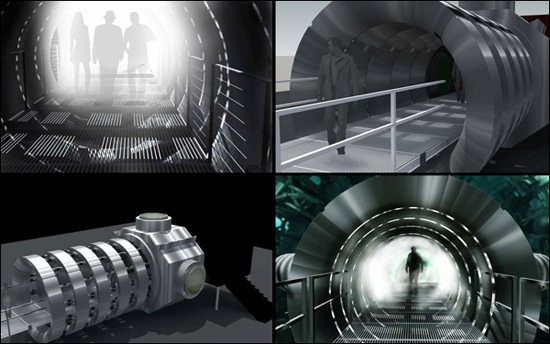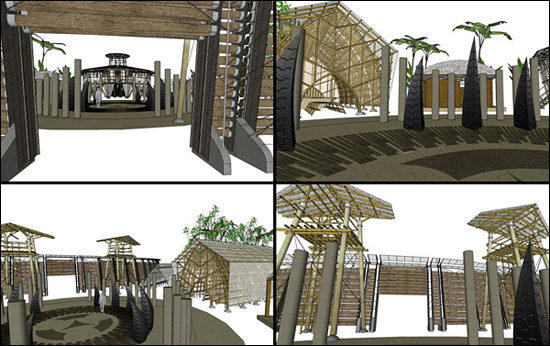TERRA NOVA - Design Overdrive by Carlos Barbosa
I was recommended to be the Production Designer for Terra Nova by Executive Producer Brannon Braga. Shortly after I personally met with Steven Spielberg at Dreamworks for an interview that lasted one hour in which I presented my concepts and ideas for the show. I was immediately hired. About a week later my deal was negotiated, agreed and signed by my agent (Montana Artists) and Fox. I was officially hired as the production designer and started work around the end of April 2010.
I assembled a small art department in a Fox facility in Chatsworth. My team consisted of the following Local 800 members:
Adam Davis - Art Director
Amy Maier - Assistant Art Director
Marco Miehe - Set Designer
Ron Yates - Set Designer
The idea was to start the design phase with a small core group in Los Angeles and eventually leave to Australia once the basic design was approved.
So how did I come up with the design concept for Terra Nova?
As with every design question, I start by defining the rules of engagement based on the script. The key here was extracted from the story. One very important element was the fact that the colonists of Terra Nova came from the year 2149 (the future) and time traveled to the era of Pangea and the Dinosaurs (the past).

The element of high advance technology was extracted from 2149 and had to work hand in hand with the raw and prehistoric natural resources. Also the fact that a small portal opened once a year for one hour through the use of a particle accelerator implied that the amount of materials and people that could be sent to Pangea were very limited but had to be sufficient to provide the building blocks for Terra Nova.

This is where I devised the solar membrane. This membrane could be shipped in rolls and consisted on a translucent polymer coated with a pattern of photovoltaic paint that was sufficient to generate energy and power from the sun in Pangea. The solar membrane could be used or wrapped around any surface to form walls, roofs, furniture, and even clothing. Each of the structures would contain enough solar membrane to provide sufficient energy for themselves.
The second element I defined was the carbon composite tubes. These tubes were inspired by the architecture of Shigeru Ban but instead of being paper tubes, they were meant to be finished in a high gloss metal finish to look like a high-tech carbon composite material from the future. By combining the endless possibilities of arrangement the tubes offered along with the solar membrane, we had developed a construction system that was very flexible and could create a variety of buildings and prototypes according to need.
The third element I brought into the mix was the natural resources of Pangea. Elements such as bamboo and lumber could also be combined to create shelter and satisfy urban needs. Having defined the key elements (Solar Membrane, Carbon composite tubes, bamboo and lumber) our art department team proceeded to create prototypes for housing and all the buildings and components for our city of one thousand inhabitants.
How did the shape and layout of Terra Nova come into being?
One thing was very clear to me; Pangea was extremely dangerous, filled with giant and aggressive predators. It had to be a walled city. We proceeded to study the plans of many medieval towns looking for inspiration. Then I came upon the layout of Burning Man and that made so much sense. Using pedestrian pathways to divide the circular masterplan into pie sections around a center space was a perfect solution.

So Terra Nova was the result of taking Medieval town models along with Burning Man's circular layout, dividing it into sectors, each sector into blocks, and enclosing the perimeter by an electrified solar powered fence. The fence was made out of solar membrane, a steel cable web and mixed with lumber from Pangea for an additional layer of protection. The pie shape concept also allowed for growth as new inhabitants arrived every year bringing with them more supplies to eventually complete the full circle.
As in every medieval walled city, a town square or main plaza provides for the main communal needs of Terra Nova. As one enters the main gate flanked by two watchtowers, we encounter the plaza surrounded by the most important building (the school, the market, Taylor's compound, the Main Hall, etc, Watchtowers were added about every 100 feet along the perimeter wall. These towers were also built with a combination of local lumber, bamboo, carbon composite tubes and solar membrane.
Taylor's compound is the center of government and tyranny. The placement of these structured had to be along the center axis of the Plaza as one entered the main gates into Terra Nova. The architectural inspiration for this bamboo structure with its own watchtower wrapped in solar membrane was that of Colombian architect Simon Velez. The layout for the compound is also circular to keep all eyes on the whole of Terra Nova. An elevated front porch flanked by two stairs was added to provide a platform for Taylor to address his people.
Also inspired by Velez's use of bamboo is the Main Hall. A very simple design, one bamboo truss repeated every four feet and covered by Solar membrane. The inside walls made of split bamboo slivers to provide a magical light quality.
The designs of the housing units, the school, and the hospital were inspired by the architecture of Shigeru Ban. Once we formulated a system for the use of the tubes, the possibilities for configuring them were endless. We created a few housing prototypes to best suit the needs of the Terra Nova inhabitants and wrap their roofs with solar membrane.
Now that the design concepts and inspiration has been explained, how did our art department function to produce over five-hundred sketches, drawings, and renderings to complete the design of Terra Nova in just under three months?
Adam Davis, Amy Maier, Marco Miehe, Ron Yates, and myself have worked together as a team now in several projects. There is a unique chemistry and real collaboration among us. Another strong thing is that to some degree or another we all speak the same language, Sketchup and Layout (with plug-ins such as Podium) and Vectorworks.
Once the design parameters have been set (rules of engagement) everyone is given the freedom to play and come up with design solutions. Like an orchestra director, I hover over the development of our ideas and steer the ship along a focused pathway.
In today's digital world it is impossible to keep to a strict definition of what the parameters of our jobs are. Most of the software and technology we are using did not exist six years ago. The pencil has been virtually eliminated. We function as a design family in a complete digital environment.
Taking individual credit for a particular rendering or drawing is difficult when the hand of all has been pushing the mouse and the tablets. Ron might have taken my doodles and concepts and developed them, pass them to Adam who tweaked them and refined them. Then Amy might have gotten them and run the 3-D model through Podium to render surfaces and lights. One of us could have taken it back into Photoshop to add an actual location photo as the background. This is how we work in our art department, a total integration of technology, talent, and ideas inside a virtual world. Some people might see this as the art department of the future but I see it as the art department of right now.
What about Locations?
Because of the script, Terra Nova required a location that offered exotic vegetation, waterfalls, giant trees, exuberant plantings, dramatic topography, and all within the zone close enough to a studio facility where sets could be built. There are only a two places in the world that I know of which meet these requirements: Hawaii and Australia. Hawaii was immediately eliminated because three other productions were shooting there and therefore no room for us.
While my art department team was busy working, I was sent on a preliminary assessment scout to Brisbane, Australia. Warner has excellent studios there, and within a fifty-mile radius I found waterfalls, ancient forests with giant trees and huge furs. On the second day and scouting from a helicopter, I found three potential sites for the town of Terra Nova. I also scouted modern Brisbane for locations needed for the year 2149 and found most of them such as Hope Plaza (the XXXX beer plant) and others. A week later I was back in LA and our art department team put a presentation for all the producers, director and studio executives showcasing our designs, the potential locations, and how the layout of our Terra Nova fitted flawlessly into the three potential Australian sites.
Everyone seemed very exited and we received a multitude of praises. It was decided that a second scout should be scheduled for a week later, this time for me to walk the director and the producers through the locations presented.
Because I kept being asked about a budget, I suggested hiring an American Construction Coordinator to assemble a budget in US Dollars. This would give us a parameter of what the numbers would be but knowing that only after hiring an Australian Coordinator we would know our reality. Our team assembled enough information to give to our construction consultant while I returned to Australia for the second scout planned.
Once back everybody was onboard with the idea of going to Australia, the location was perfect. Our Art Department team continued the design process and prepared to move to Australia.
I had been working on the show since the end of April and on July 21, 2010 and out of the blue, I was asked to turn in all the files we have produced for the show and laid off under the assumption that I was too emotionally attached to the design of the project and would be unable to make the necessary adjustments to reduce the scope of the design and deliver a project in line with the studio's allocated budget. Mind you it was an assumption since we had not even started construction and nor did we have an accurate Australian estimate.
I was told that our designs were great and that they were going to implement them and that my production designer credit on the pilot of the show would be granted.
I was totally shocked but I proceeded in a professional manner. I produced and turned in a total of 4,302 (four-thousand, three hundred and two) digital files. The files included over five hundred renderings, sketches, hundreds of conceptual sketches for architecture, technology, vehicles, wardrobe, animal life, plants, landscaping, urban planning, and hundreds of location photos.
As requested, our drawings were delivered to the producers. A new production designer was hired with the mandate to follow the established design, and the budget … well … we all know what happened there. In the end, the project vaguely resembles the original concept. Is it better, worse, or simply different? Let the audience be the judge.
At the time I did not understand why - had I not been let go of Terra Nova, I would have never been involved with the best project that has come my way in my career: Magic City. Now it all makes sense.
Carlos Barbosa
Production Designer